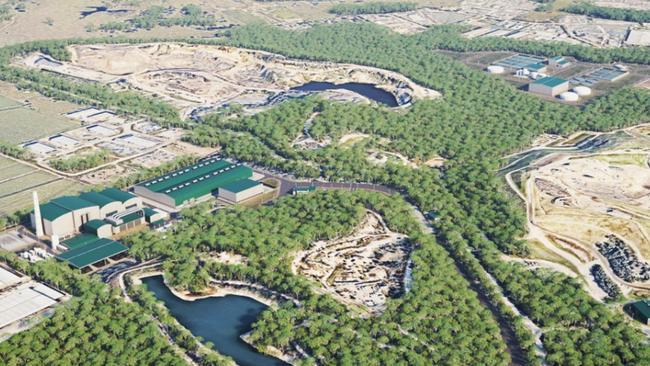City must build recycling plant in a ten years or ratepayers face huge waste bills
Gold Coast City Council is in a race against the clock to build a $2 billion green waste plant but new details reveal its cost won’t be anything like that. FIND OUT MORE
Gold Coast
Don't miss out on the headlines from Gold Coast. Followed categories will be added to My News.
Council officers have estimated a proposed green waste plant in the region’s north will cost $1.6 billion.
And city hall insiders say council faces a big decision as to whether ratepayers or private industry will fund it.
Senior council managers have put forward a 10-year plan for councillors, which includes the financials for the project. The program’s capital spend is $1.6 billion alone for delivering eight facilities.
Officers have noted that funding includes both “private and public investment”.
Council sources said councillors must make a call on “do we own this thing”.
The alternative is a potential repeat of the messy Allconnex drama more than ten years ago where council fought back to control its water and wastewater services after they were outsourced. A feasibility study is expected to be completed by July next year, with a decision made in the following 12 months allowing construction to start in 2026.

Mayor Tom Tate views the Advanced Resource Recovery Centre at Stapylton as a bigger priority than upgrades to the HOTA arts precinct and Greenheart parklands and wants the City to retain an majority ownership.
“We’ve got to keep control of it.’ Mr Tate told the Bulletin.
“If we go the path of private public partnership – public meaning three tiers of government and private coming in to get an earn of it. With the partnership there, the Gold Coast City must retain – whether it is exact or not – at least 51 per cent.
“Because we want to be a master of our destiny of our future waste management.”
Mr Tate said the project was the most important one on the agenda, given the ever-growing Coast population.
“This is the most critical part of keeping our lifestyle intact for current Gold Coasters and new Gold Coasters to come. It is the most significant project in the history of the Gold Coast,” he said.
Council’s current estimate to deliver the ARRC program is based on building eight facilities and covering a waste levy charge for the remaining three per cent of waste which would need to be landfilled.
The ARRC components include a sewage treatment plant, recycled water treatment plant along with facilities for recycling, organics and construction waste.
The precinct would also include a green hydrogen electrolysis plant, residual to waste energy facility and community education centre.
The ARRC would be on two lots of land at Rossmanns Road, Staplyton. The City is about to roll out information sessions to residents in the north later this month.
A pre-feasibility study in August last year estimated the alternative of using third party landfills would cost ratepayers about $3.4B.
This included the waste levy charge, landfilling gate fees, transport to a third party landfill outside of the Coast and standard waste collection costs. The net savings by implementing the ARRC program over the next 30 years is expected to be about $1.8B.
The cost estimates will be reviewed over the next 18 months as the project develops enabling consultation with contractors and delivery partners.
First look: Plans revealed for $2bn Coast recycling centre
Gold Coast City Council is in a race against the clock to build a $2 billion green waste plant before landfill capacity runs out in ten years.
Councillors in confidential briefings were told “significant studies” had to be completed before the proposed Advanced Recovery Resource Centre (ARRC) could be built.
Council has begun buying up and identifying parcels of land to support an ARRC at its future waste management and recycling precinct at Stapleton.

A pre-feasibility study says a high level pathway has been mapped out to start key environmental reports to ensure the commercial operating date was “less than 10 years”.
“There are significant studies required for the precinct to be construction ready,” officers warned, in a report last year.
“However, the environmental and planning studies required for approvals will need to progress as a priority, to ensure the city has the ability to achieve operation before landfill capacity for the city is exceeded – within the next 10 years.”
Parts of confidential reports now made public also show what the ARRC would look like. A council source said the ARRC was a priority otherwise ratepayers faced a huge financial burden in having waste trucked up to three hours away from the Coast.
“Ratepayers can’t afford the cost of putting it out that far. It’s a ticking clock in terms of our capacity left,” the source said.
A City report said the key components of recycling and energy precinct included:
* a new northern sewerage treatment plant
* a future material recycling facilities (MRF) to replace an ageing one at Carrara.
* the waste to energy facility, needed because no alternative landfill sites exist in the city.
* A green hydrogen electrolysis plant (HEP), to support waste collection and help energy production.
Officers when briefing councillors in August last year said a key component for advancing the project was community and stakeholder consultation.
A council spokesman confirmed community engagement would begin this week on the recycling and energy precinct which would divert up to 97 per cent of waste from landfill. Mayor Tom Tate said it was vital the Coast reduced its reliance on landfill and estimated that capacity would be reached at current facilities within 10 years if no suitable new landfill sites were identified.
He said the proposed ARRC for Stapylton was an eight-pronged approach to increase recycling and used residual waste to generate energy.
“A pre-feasibility report found that this proposal not only offered economic and environmental benefits but would also divert up to 97 per cent of waste from landfill,” Mr Tate said.
“Landfill is outdated and there are innovative, more advanced options available to us that are better for our environment and for ratepayers.

“We can create a world-class sustainability hub here and create a future where recycling and green energy production dominate our waste management. It will also reduce the City’s cost to manage waste over the next 30 years in the order of $1.8 billion.”
Community groups are asking council to focus on improving ageing infrastructure after a sewage leak led to at least 364 million litres of sewage – close to 145 Olympic swimming pools full – being spilt into the Albert River.
The Bulletin in a series of exclusive reports revealed pipe leak began as early as mid-January.
Originally published as City must build recycling plant in a ten years or ratepayers face huge waste bills



